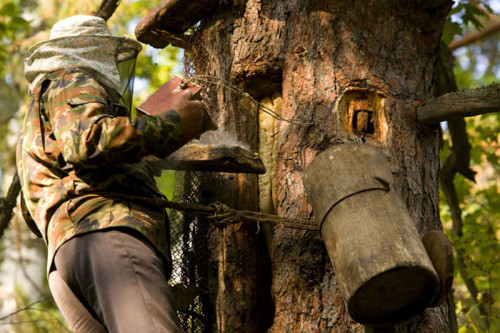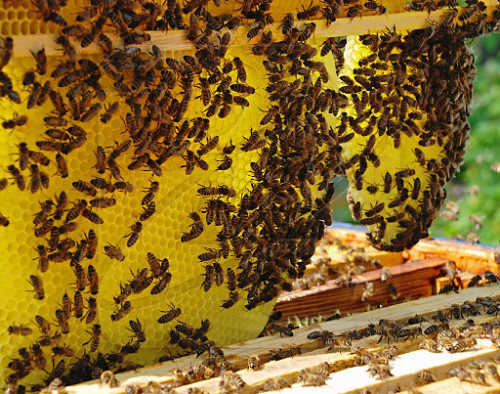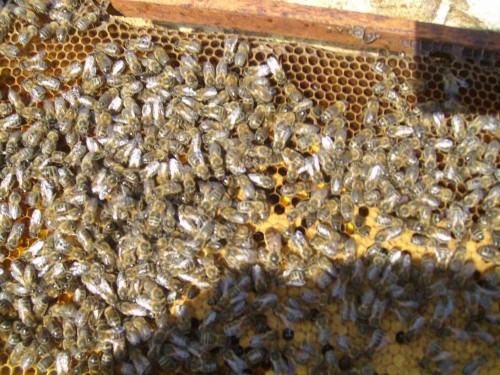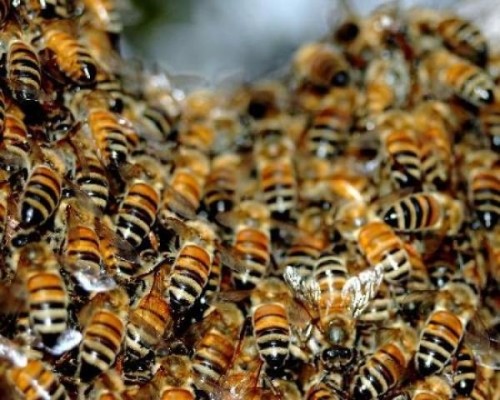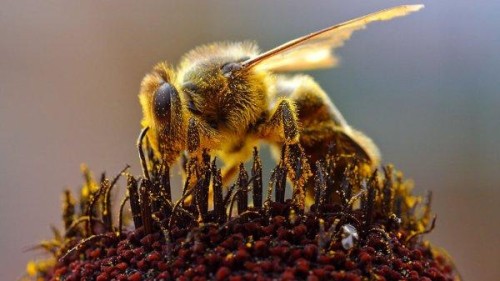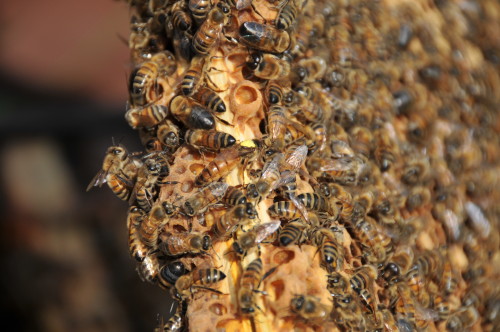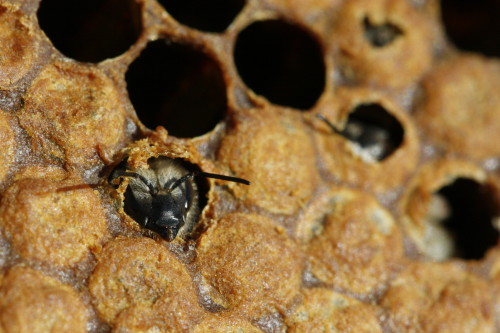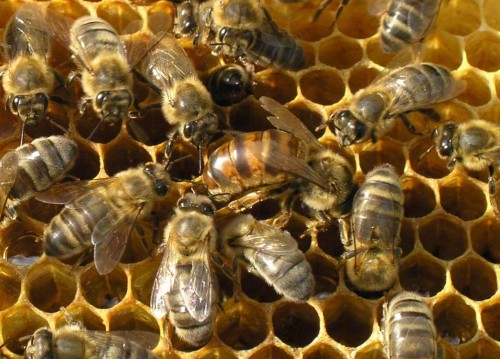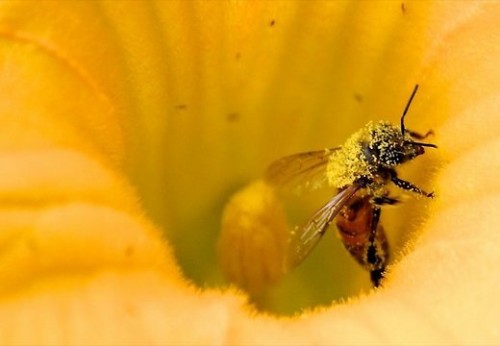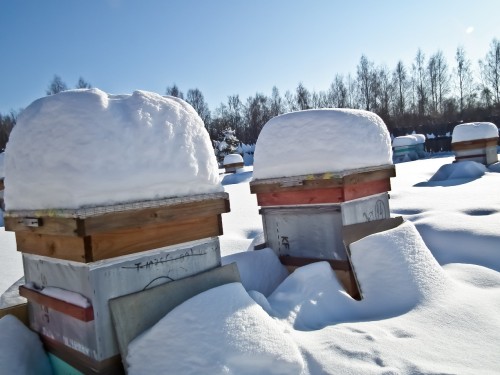Beekeeping begins with apiary. Competently built, it should be addressed by the pilots to the south, and to be on the territory protected from the wind. In this article, we will tell how to properly breed the bees during the period of the entire cycle of their activities: from the spring awakening before preparation for the winter.
Content
The first willow
As soon as the spring air warms up to 12-13 ° C, the bees are taken out of wintering workers. Some beekeepers are enough to carry out one general inspection. In the event that the family poorly moved the winter, the bees sick, sluggish or lost the uterus, the cleansing roar passes hard.
A strong family looks differently: the roar flows together, energetically.
If suddenly you notice the dead insects in the area of \u200b\u200bthe fly, such a hive should be examined in the first place: perhaps the bees in it were killed. In the hive, where the loss occurred, the bees behave restlessly, as if looking for someone, publishing the sound.
In the wild nobody regulates the time of awakening the bees, and different families can wake up differently. In the conditions of Academy, if the beekeeper wants to get a May or Akacian honey, in his interests hurry insects with a flush, and thereby provoke the early family development.
The range of the edge ranges between March and the first days of April. In some southern regions, this process is even at the end of January.
After the first cleansing depth of the bees is still very weak and they need a place to sit down and relax. Therefore, take care of the shields next to the hives.
For the root, it is better to choose a sunny windless day with a plus temperature. The beekeeper leads a magazine where he registers which family is flushed, and what is not yet. When a family is in no hurry to start flying, it does not mean that it died: if a smooth buzz is heard in the hive, perhaps the bees have not yet woke up. Such a nest is better to leave alone until the next sunny day.
If the weather is expected to be worsening, light tapping on the wall of the hive, the bees can be "invited" to fly, after opening the lid.
Strong families - a consequence of the proper bee care
In a healthy family, the bees, as a rule, there is only one female individual - the uterus, which has well developed all reproductive functions. It gives life to both workable bees and drone.
The reproduction of wild bees occurs through the rotation. During this period, the family builds special cells (Rye Mercelines), where the larvae is grown. Usually these cells are located on the edge of the nest. A few days before young individuals comes out, the old uterus leaves the hive along with several thousand working bees to give the opportunity to develop young people. They now need a new uterus, and they begin to cultivate it by choosing one of the working bees.
All industrial methods of malfunction are based on this principle. Stimulating feeding plays an extremely important role in the cultivation of the uterus. It has a positive effect on the rapid development of the family and the right growth of larvae.
In the hives with strong families there are more than a dozen frames, completely dispensed bees. Where the family is weak - they are only somewhat. If the breakdown is normal, it means that everything is in order with the uterus and do not need to look for it.
Early spring feed is still not enough, so the bees need additional feeding. Each family consumes at least 10 kg of honey and 2-3 frames with Perga. Moreover, it is surprising that a strong family consumes half the heat and feed, in relation to the same number of insects in a weak family. Therefore, in the spring in such families, there are so many frames as the bees are capable of covering tightly.
While the stable bribe is not yet, it is useful to put one or two frames with honeycombs. As soon as the bribes appear, add a frame with an artificial trap.
An important condition for productive apiary is a sufficient number of good cells. For example, on each family in the hive of 12 frames, 12 cells are required, respectively in the nesting framework and 24 in the store. If the family lives in the hives, it is required at least 20 nesting and 20 shopping frames. In the two-circuit hives, the bees are required by 24 cells, and in multicompute - from 40 pieces.
It is very important what quality they are. Over time, the volume of cells of old, dark cells decreases, and the bees from this becomes the smallest and weaker than their fellows growing in bright cells. Normal service life - about two years.
Useful information about bees
In tribal derivation, it is necessary to consider the bee family as a holistic biological unit. After all, it is precisely the performance indicators of the whole family indicate the quality of drone and diet. At the same time, the workability of the offspring depends on the individual of the female.
Drum's hereditary deputies are obtained from the module. They develop from non-advocked eggs and have half (16) chromosomes. From fertilized eggs, uterine, which inherit DNA both drone and mothers, and therefore, the number of chromosomes they have 32. Fertilize the egg when laying or not - solves the fetail. In the process of mating with a drone, its seed fluid penetrates inside. Subsequently, at the time of laying of women's larvae, if necessary, inject a substance from its seed bag into an egg, thereby fertilizing it.
If the uterus is screaming in drone cells, the egg accesses non-secretive.
How families breed
At the beginning of the spring, one larva accounts for approximately one and a half of the root, but after a month this figure is three times more. It grows up a huge number of universal young insects, thanks to which they are manifested by the instinct of natural rosium. Since it is still too early to collect nectar and they cannot direct their forces in the workplace, they remain only one thing: multiply and separate to a new family.
In the process of preparation for rose, rose uterus grown. This is a typical bee instinct, thanks to which they multiplied in wild conditions and on the Pomegers of our great-grandfathers. But the fact is that at this time the egg production of the uterus is strongly limited, and, consequently, the breakdown. As a result, the construction of cells and collecting nectar decreases. Therefore, here is the task of the beekeeper - wait for the disbursement and quickly remove all the Musicians, leaving one best uterus. Gusts to natural rose in the conditions of the production of honey you need to warn: in advance to select the bees unoccupied in advance, making artificial formation of families.
There are several instructions, how to breed the bee family, and for beginners we give some techniques. The first of them is called "weapons":
- For 7-8 weeks to the most abundant bribe in the most healthy and strong families temporarily isolating the uterus.
- They put the partition in the hive, take a frame with the most mature printing breakdown together with the bees bumping it, and additionally add insects there with two more frames.
- Deliver two frames with food and put a non-friction uterus. In the evening, all the flights will return to their maternal family.
- After a couple of days, they check whether the uterus is adopted. They look into the nest and follow, do not remove the bees of the Musicians. If this happens, they should be destroyed and again give a prompt uterus.
- As soon as the breakdown appears, the drains are enhanced by an additional frame.
The second option: 5-6 weeks before the bribe, create a firing uterus. The technology is the same, but the development of the family takes place for two weeks earlier, therefore more bees and broods are hidden in such a dressing.
The third method, according to the principle of the national team, for which the breakdown is taken from 2-3 strong families. It is better to do it in a couple of weeks to the main health profession and, provided that there are no diseases at the apiary.
The fourth way is the division of the family on the floor. Nearby is similar in shape and color of the hive, but empty. It is transferred to half the frames with bees, half of the feed stocks and press the fruit uterus. Upon return, flight bees will be divided about equally equally between two hols. Thus, two families will be formed.
Conclusion of module
Egg production of the uterus decreases after the second year of life, therefore, in industrial conditions, the modules are not held over two years.
To bring the uterus, breeding bees at home should begin with careful selection of parents, from which it will inherit its qualities. It is important here both the heredity of the uterus and drone. The elimination of a large number of reproductive males pay special attention. For tribal selection, the highest requirements are presented to the males. The main thing is the ability to fertilize over several years of life of the same uterus, as well as a strong family during the period of the whole season. Of great importance is the immunity of bees to various diseases.
There are tests to determine the main signs of proper selection, which can be carried out with even a novice beekeeper. For example, a sugar syrup test test, which makes it possible to see the readiness of the bees to collect and recycle nectar. Another check is the definition of sanitation abilities when a frozen fragment of the printed breakdown is placed in the center of the socket. The beekeeper registers the quality and speed of purification of the fragment.
A family-teacher lives in one of the nests, which is responsible for feeding the module. In such a hive, they write: "Maternal". Its hive consists of two compartments with a partition, in which there is a window from the separation lattice. In a smaller part, larvae are placed, and in the greater - the uterus is located. In the same place where drutones are growing, they write: "Food".
Two weeks before the output of the queen, the father's hives put a framework with drone cells. In the rest of the families, the withdrawal of the drone is not allowed. When bribes appear and a large number of drutones remain at the apiary, the time of the module is coming.
Reception of larvae occurs at the starter - a special box. On the design of the starter, as well as how to breed the bees there is a lot of video material.
Now you need to provide bees with food, so the starter put two filled honey-perdic and one empty frame. The latter is needed to accommodate syrup. Two pergivers fall on two vaccination frames.
- The bees shake into the starter from the printed brood - these are young individuals, which in this case are especially needed, as they will highlight the necessary uterine milk.
- Frames with a breakdown are placed in the compartment for young bees in the hive family-educator, which allows you to grow up the maximum number of nursing bees.
- In the center of the starter, leave the clearance for the vaccination framework, which will need to be placed there after the day. There are about 2 kg of bees.
- After that, the starter is closed and transferred to a dark cool place, not forgetting to feed insects in it.
- Before the vaccination, the frame on which the planks are fixed with larvae are watered with syrup and placed for several hours into a strong family, where the bees will be cleaned and submitted feromones - biologically active substances. This will facilitate the process of developing larvae.
- Material for vaccination take certainly from the breeding family and carry into the laboratory. Here, carefully cutting the cells with larvae, they are on one, free rows, attached to the vaccination frame. For vaccination, only young, one-day larvae are suitable.
- The vaccination frames are placed in the starter, and instead of fusion watered bees with water - it prevents them from flying and beneficially affects the adoption of larvae.
- In addition, the sponge moistened in the water in the water, which plays the role of drinkers.
- After that, the starter closes and serves a feeder with 50 percent sugar syrup.
- A day since the vaccination, the starter is placed next to the hives of the educator. The vaccine frames are put in advance prepared socket compartment. The remaining bees also shake over the installed framework. To safely complete the operation, you need to not forget to quit insects again.
In industrial conditions for breeding bees, wax bowls are formed in the laboratory, which are attached to the frame with a hot wax. Then, using a special tool - a spatula, move tribal larvae in them, pinned a little milk to each of the bowl. Further, the procedure continues similarly.
It happens, bee families do not take larvae to uterine education. It is necessary to find out the reason for this and place a new vaccination frame. The accepted larvae is abundantly feeding with milk and build spacious castres on the basis of existing cells for them.
Tip: Color the frames in different colors to facilitate work, depending on their purpose. For example, for a young brood - a red frame, for Perga - white, for vaccine - green.
After 4 days, the larvae cease their growth and the moment of last feeding is coming. After 11 days of the uterus are ready to leave the Musicians and the first thing they should be isolated. If this is not done on time, then the first outstanding uterus can be destroyed by the rest of the opponents in just a few minutes. No later than 10 days later, the Musicians conclude into small cells from plastics, thereby protecting other bees to do not shrink them.
The process is repeated throughout the season: Mature Musicians are selected, and the next frame is immersed in the seven-educator. Scientific experience has shown that artificially bred uterus is superior in their qualities of ROOLE and fiscased individuals. Good fruit dying transplant to other hives, and also sell.
How to care for bees during the training period
The most important task of the butt - bring to perfection the technology of the bee content by the time of the main medical device. It is obliged to provide the hives with a sufficient amount of honeycomb, since for a strong family of the volume of 12-frame beehs is not enough. Separate applies, as well as the addition of housings. It is very important to warn it, by adding the bees of the working space. It stimulates the release of wax and provokes to build new honeycombs.
Someone where to launch the utensils, while dividing the aperture hive. By the time of the main bribe, the separator is removed, leaving the best uterus. This makes it possible to get a very strong family whose productivity will be up to 30% higher than in the hive with the extensions.
To direct the working bees for the collection of nectar during the primary bribe, their uterus is sometimes removed, or replaced its other, untouched. For that period, while it matures, and then mate with drones, insects freed from raising a breakdown will have time to take a bribe.
Wintering bees
Already during the main bribe, take care to ensure families a good feed for the winter.
- You need to leave as many frames with honey as bees will be able to cover. In the southern regions, each nest should account for at least 15 kg of honey, and in the northern regions where wintering lasts longer - 18-20 kg. In addition, for food in early spring, they still keep 10 kg per family.
- Upon completion of the main bribe, the bees are fed by sugar syrup, thereby saving honey in favor of feed reserves.
- Nests are well insulated and inserted into the threads barrays from mice.
- In the southern regions of the hives leave in their places without outdoor insulation.
Where many snow and moderate frost fall out, hives are in a row on a substrate from coniferous branches, covered with snow. So they are cast from the fluctuations of the temperature and gusts of the wind.
In the northern conditions, one-seated hives are additionally insulated with straw, chips or dry leaves.
If the climate is too severe, the hives are transferred to the room where the temperature is maintained close to zero and humidity of 70-80%.
A strong family is a young uterus and strong, not yet extended by the work of the bees. Such a hive successfully survives the winter and will revive the former power. High-quality preparation of apiary to wintering is the key to its productivity next year.
Dictionary of Terminov
Spring deployment is an important event in the bee and in the life of the butter. For the winter, the exchange processes of insects slow down, and when they gain them, they finally appear, the ability to clean the intestines and come to the tone, which will have a beneficial effect on the development of the family as a whole.
Bribes - the period of the most magnificent flowering of medical plants, providing bees abundant food.
The pilot is a slot in the hive, through which the bees leave the socket and return back.
Perga, otherwise, bee bread is a product produced by bees from flower pollen by processing its secreted salivary glasses. Perga is torn to honeycomb and is preserved by a lid from the honey, where he wanders for several months, thanks to lactic acid bacteria. Bee bread is a harvested "future" food for growing larvae and food of adult bees.
Printing breakdown is the stage of growth of larvae when they reach the state of the pupae and to continue the growth of working bees seal them in a thin bottom.
Frames are nesting and shopping. In the nests there are reserves of Perga and Möday and incubating new bees in them. Only honey gets into the store.
Breakfold - postponement by the uterus of larvae and the organization by it of a broken nest.
Raine - the ability of the bees to multiply and settle down.
Beyu-lyrzhak is one of the most common structures of the hives among lovers, and is calculated, as a rule, on the 20 frames.
Updation - postponing by the uterus of eggs.


